How To Buy Domain Name

Are you looking to register a domain name, but don’t know where to start?
Part of building a website, is buying a domain name that has to be unique.
In this step-by-step guideline, I’m going to show you several options on how to register a domain name and also cover some commonly asked questions that might pop up in your mind while registering a domain.
But let’s first start by explaining why is it crucial to choose a good domain name.
Why a Good Domain Name is Important
A domain name is your unique identifier among billions of other websites on the web.
That’s why having a memorable and easy-to-type name is essential for having an online presence.
Your domain name serves as an extension of your personal or business name.
In that sense it:
- Improves recognition and awareness.
- Adds extra credibility to your venture.
- Eventually boosts visitors’ recall.
Also, choosing a good domain name is important for SEO.
Several years ago exact match domains (EMDs) were all the rage, but today most people choose brandable domain names.
Memorable domain names get typed to Google more frequently.
Algorithms keep track of that and assign more authority to your website.
As the branded search volume grows, your domain name earns extra authority points, so that it gets easier to rank for related keywords.
With that being said, let’s move on to the how-to part.
How to Register a Domain Name
4 Options:
- Using Domain.com.
- Using GoDaddy.com.
- Using Namecheap.com.
- Using Bluehost web hosting (offers free domain for 1 year).
To get a domain name, you’ll need to ‘call dibs’ with ICANN.
ICANN is a global non-profit authority that maintains records on which domain and IP address belongs to whom and manages access to them.
But ICANN doesn’t provide registration services, it only maintains records.
That’s where domain name registrars come into play.
The primary role of a register is to:
- Coordinate claims on different domain names.
- Match specific domain names with Domain Name System (DNS) nameservers.
- Ensure that there are no duplicate domain names.
Technically speaking, you are not buying a domain name from a registrar company, but reserve its usage for a specified time.
You can pay to reserve a domain for 1-10 years at a time, depending on the registrar.
After your initial subscription expires, you’ll need to renew it and pay a fee again.
You can re-purchase your domain name over and over again.
In practice, all of the above is much simpler than you think as we will show below.
How to Get a Domain Name from Domain.com
Domain.com is a reputable domain registrar, launched in 1998.
Over 1.2 million websites are registered with them.
Domain.com features the most popular top level domains (TLDs) such as .com, .net, .org, .co, along with over 25 county-specific domain extensions (.fr, .au, .co.uk, and more).
They are mostly selling affordable domain names with most names priced in the $9.99-$12.99/year range.
If you are lucky, you can also steal a deal and buy your domain name for as low as $2.99/year.
For that price you get:
- 1-year domain ownership.
- Free SSL certificate for extra security.
- Automatic email forwarding to your domain.
- DNS registration and management tools.
Also, you can purchase extra Domain Privacy+Protection for your domain (costs $8.99/year).
In this case, your personal details will not be displayed publicly in the WHOIS/ICANN directories.
Plus, the registrar will also run extra security checks.
Here’s how to register a domain name on Domain.com.
Step 1:
Run a quick search to verify that the domain name you are eying is available.
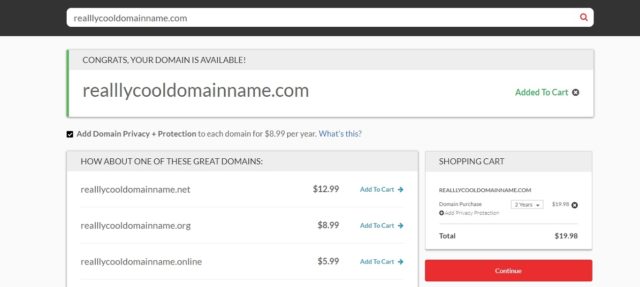
Step 2:
Pick your domain extension.
Go for .com since it’s the most familiar option among users and thus, people, tend to type .com before trying anything else.
Your choice gets automatically added to your cart with a 2-year privacy protection subscription.
This one’s optional, so you can remove it during the next step.
Also, you can change your domain renewal period from one year to five years.
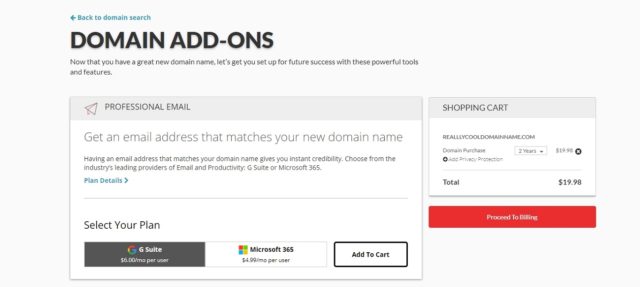
Moreover, you can pick some add-on services such as:
- A professional email address, matching your domain name.
- Access to a drag & drop website builder.
- A web hosting plan (don’t rush to grab it!).
- SiteLock website security tool.
Step 3: Provide your billing and payment information once you are done with your selections.
Add a coupon code if you have to get 25% off of the first payment, review your choice(s), and proceed with checkout.
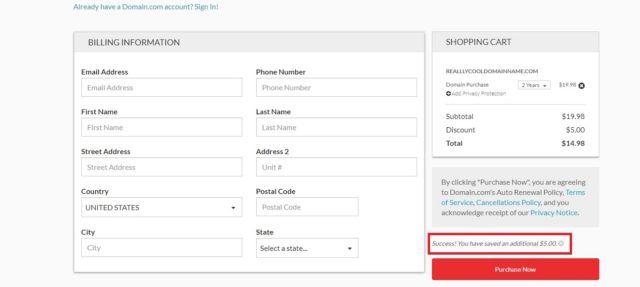
Note:
Re-check your domain spelling before hitting “Purchase Now”.
Domain.com doesn’t let you change your domain name post-purchase if you misspelled it.
How to Register a Domain on GoDaddy.com
GoDaddy is also known as a web hosting provider, but you can also buy a domain name from them.
Step 1:
Look up a new domain name first.
If you haven’t come up with a good name yet or are assessing different options, GoDaddy has a nice set of extra features to help you out.
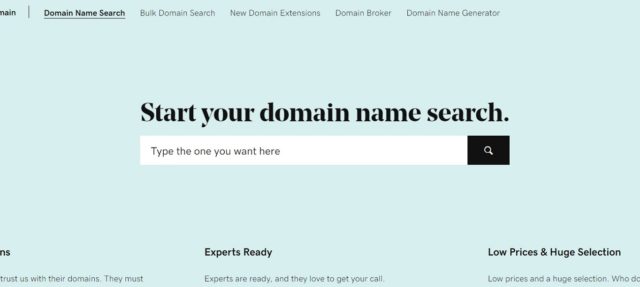
You can use the Bulk Domain search to check a bunch of domain ideas for eligibility in a click.
Or you can play around with their free domain name generator to get some alternative suggestions if your primary choice is already taken:
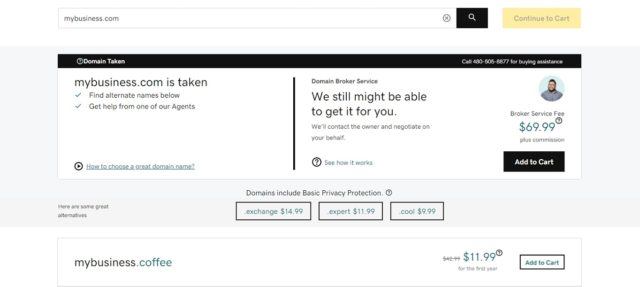
Also, if you are feeling very determined to get your desired domain for branding purposes, GoDaddy can try to broker a deal for you with the owner.
But remember, the original owner may name any price they deem appropriate so in that case, you’ll be paying:
- Domain purchase fee to the seller.
- GoDaddy Domain Brokerage commission.
- The regular yearly subscription price for the selected domain and add-ons.
If you are running a small business, going into a heated negotiation with some cyber squatters may not be the best investment of your time and budgets.
Wait out and see if the other person forgets to renew their domain or abandons it so that you could snatch it then.
GoDaddy has a Domain Backordering service (starting at $24.98 per domain) where you can reserve your place in line for a specific domain.
If there’s more than one buyer, the domain goes on auction.
If it’s just you only, you get it immediately.
Step 2:
Once you’ve made your pick, grab all the TLDs you want to your basket and then select your renewals period (1 to 10 years).
GoDaddy regularly runs different promos, so it’s easy to get a really affordable domain with them. Also, the annual rate includes:
- The ability to create up to 100 subdomains for your website.
- Basic privacy protection: your personal details will not be visible on WHOIS.
- For personal name domains: free forwarding to your Facebook, LinkedIn, or Twitter account.
- Real-time domain monitoring and security tools.
- Excellent customer support.
Step 3:
Once you’ve finished filling your cart with domains, click proceed to checkout.
At the next screen, you’ll be given an option to pick some extra handy features such as:
- Extra domain privacy and security coverage.
- Free “Coming Soon” page.
- An email address to match your domain.
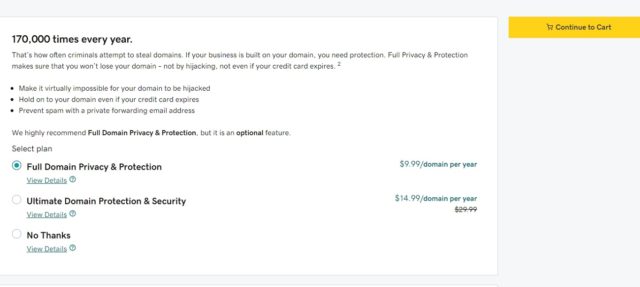
Step 4:
Continue to your cart and carefully review your purchase summary.
Pay attention to the fact that GoDaddy charges a lower rate for 1-year domains.
But the price may go up if you sign up for 2+years.
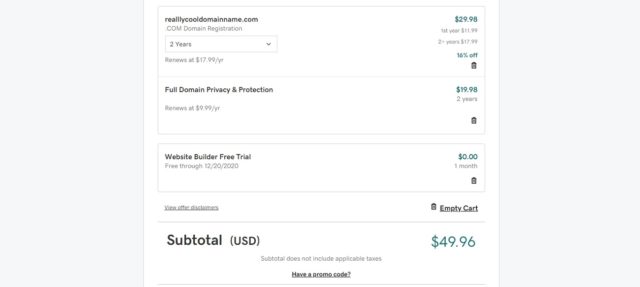
Again, you’d be pitched several upsells in case you change your mind.
Step 5:
Create an accounting or sign in using your Facebook or Google Account.
Step 6:
Provide your billing information.
Then add a valid payment method (remember: you’ll be auto-billed each year, so your card shouldn’t be too close to expiring).
Review all the details one last time and click ‘purchase’ to get your new domain name(s) registered.
How to Get a Domain Name From Namecheap.com
Namecheap is another popular website for buying domain names and getting website hosting.
As their domain name prompts, they often have a lot of good deals and somewhat lower annular prices than GoDaddy, for example.
So if you love a good bargain, here’s how to buy a domain name via Namecheap.
Step 1:
Run your desired domain name search first and review available options.
Namecheap has a really huge collection of new TLDs such as .art .digital, .luxury among 400+ other options.
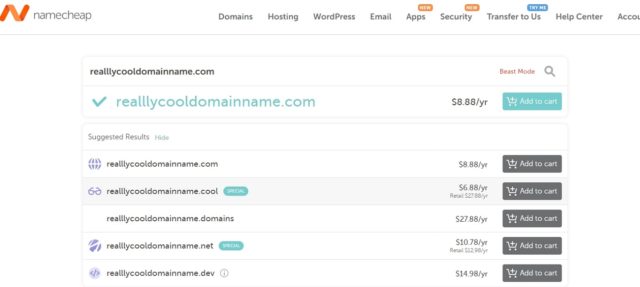
Also, if your name isn’t available or you’d like to get some more ideas, switch to their advanced search view aka the Beast Mode:
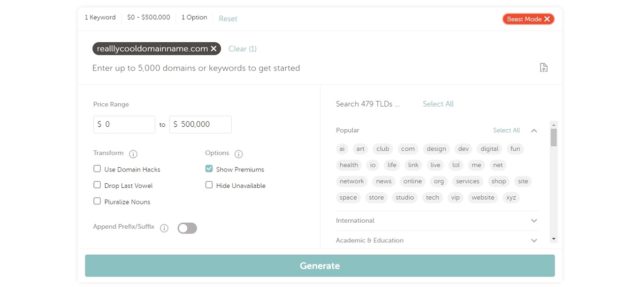
As you can see from above, you have a lot more features to play with such as price range, suffix/prefix, and so on.
This can help you drill down to that perfect domain name that is short, memorable, available, and yet cheap!
Step 2:
After you’ve chosen the best contenders, proceed to your cart to start the checkout process.
At this point, you can also add some extras and customize your order:
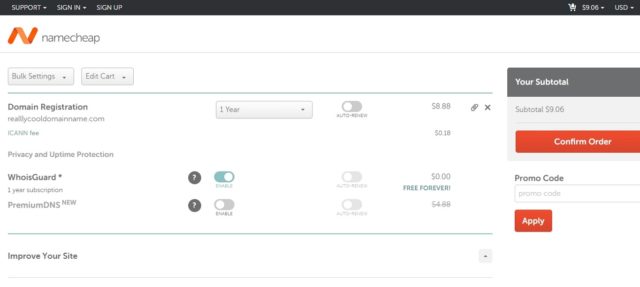
With Namecheap, you get a lifetime free WHOIS protection for every domain name, plus they recently added a bonus premium DNS offer (priced at $4,88/year).
When you enable it, your domain gets yearly protection against DNS/DDoS attacks (that are on the rise!), plus ultra-fast global DNS response.
This gives you some extra leverage in terms of your website speed.
On top of that, you can select some affordable up-sells such as:
- A yearly hosting plan with a website builder included.
- Dedicated managed WordPress web host.
- SSL certificate for extra protection (recommended for websites processing payments).
- VPN subscription.
- A professional email address for your domain.
Also, you can play around with your renewal.
Namecheap provides a small discount for 2+ years.
Step 3:
To confirm your order you’ll need to create an account with Namecheap.
However, they don’t offer an option to log in with Google or Facebook, so you’ll need to provide an email address.
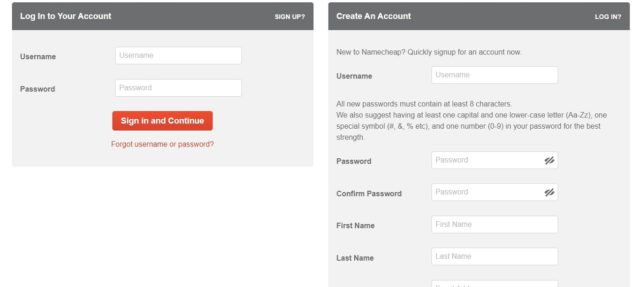
Step 4:
After login, you’ll need to provide your billing details, add a payment method, and proceed with the purchase.
How to Register a Domain Name For Free (Using Bluehost)
You’ve heard the rumor about free domain names.
Is it true?
Yes! There are actually ways to get a free domain name for your website.
First, you can get a free domain name for a web hosting provider such as Bluehost.
They offer every new user a 1-year free domain with any of their hosting plans.
You can either register a brand new domain name with them or transfer a domain name, registered with another company.
Some other hosting providers who also have a 1-year ‘free domain’ policy:
- HostGator
- Dreamhost
- InMotion Hosting
Note:
The downside of getting a domain name from a hosting provider is more expensive renewals.
After a free year, most hosting providers will charge a higher renewal fee, compared to domain registrars.
FAQs
Here are some commonly asked questions.
What are Domain Name Extensions?
Domain name extensions help categorize different domain names.
It’s a special hierarchy, invented for the Internet.
You can choose among popular top-level domain extensions (TLDs) such as:
- .com
- .org
- .net
Or go with a local domain extension such as if you want to focus on building a presence in a specific country:
- .co.uk
- .es
- .fr
- .au
Also, there’s a bunch of creative domain extensions, launched recently.
You can try playing around with them to create a shorter, brandable name.
For example:
- Alchemi.st
- Autu.mn
- Dear.ly
- Handma.de
How to Buy a Website Domain for Ever?
As I explained, domain names are not for complete sale.
Essentially, you are reserving domain name usage for a set period (10-years max at a time).
But you can keep renewing your domain name as many times as you want to.
While you cannot buy it out for good from a registrar, you can hold on to your domain name for as long as you are paying your renewal fee.
What Happens If I Don’t Renew My Domain Name?
If you didn’t set auto-renewal or forgot to manually do so despite the reminders from your domain registrar, your domain name will expire.
This means several things:
- Your website will no longer be accessible by anyone who types your URL.
- The domain name will be available for sale again, typically in 30-days or so after expiration.
- It can also be auctioned on a website domain auction.
In essence, failure to pay a renewal fee means lost access to your domain.
Can I Transfer My Domain Name?
Yes, most domain registrars can also facilitate the process of transferring a domain name from one person to another (if certain conditions are met).
For example, if you want to buy a premium domain name from someone, a registrar can help process the deal securely.
Also, you can transfer your domain name between different registrars if you found a better deal, for example, or just need some extra features.
Below are linked help documents for doing that with each registrar:
Conclusion
Congratulations! If you followed through with our step-by-step guide, you should now know how to register a domain name.
What you need is come up with (or research on the platform) a sound word combo, decide on your domain extension, pick some handful add-ons, and pay for your subscription.
Afterward, the registrar will provide you with further quick instructions for connecting your domain name to your website, so that you can finally become visible on the web.
Have a question about how to register a domain name for your website that is not included here?
Leave me a comment below or contact me.




Comments